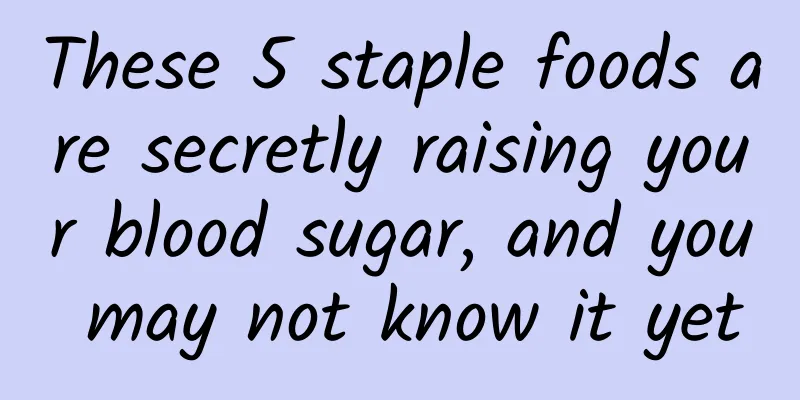These 5 staple foods are secretly raising your blood sugar, and you may not know it yet

|
In our daily diet, we often choose some staple foods that raise blood sugar slowly in order to control calories and blood sugar, such as buying whole wheat bread in the morning and eating brown rice at noon and in the evening. But do you know? These "slow blood sugar raising" foods that you often eat actually raise blood sugar very slowly! Today, I will show you 5 staple foods that you thought raised blood sugar levels slowly, but actually do raise blood sugar levels quickly. 01 Brown Rice A definitely high GI staple food, whether it is indica rice or japonica rice, their brown rice GI is very high (Indica brown rice GI: 71, Japonica brown rice GI: 78). The long and thin ones are Indica rice. The pictures are copyrighted images. Reproduction and use may cause copyright disputes. The short and fat ones are stalked rice. The pictures are copyrighted images. Reprinting and using them may cause copyright disputes. It is easy to understand why white rice raises blood sugar levels quickly. Refined white rice is brown rice with the seed coat, aleurone layer, and germ removed, and the remaining part is almost all the endosperm. The main component of the endosperm is starch. Without the protection of the seed coat and aleurone layer, the starch is completely exposed to the outside, making it easy for digestive enzymes to come into contact with it and be easily digested into glucose and absorbed into the blood. Therefore, white rice raises blood sugar levels quickly. However, as a whole grain, the endosperm of brown rice is tightly wrapped by the seed coat and endosperm. Logically, the starch should not be easy to digest. How can it cause blood sugar to rise so quickly? The reason why brown rice increases blood sugar content quickly is because of soaking the rice. Brown rice is difficult to absorb water due to its seed coat. If you don't soak it before cooking and cook it the same way as white rice, the brown rice will be undercooked and no one would like to eat it. However, if the brown rice is soaked, especially at a higher temperature and for a longer time, it will absorb enough water, and then the starch will be more easily and thoroughly gelatinized when the rice is cooked. The more thoroughly the starch is gelatinized, the easier it is to digest.[1] In addition, when the brown rice absorbs enough water, the seed coat may burst when the rice is cooked, which will also make the brown rice easier to digest. If it is easy to digest, the blood sugar level will naturally rise faster. Some friends may say that they did not soak the rice, but most of the time you chose the brown rice mode when stewing rice. Have you noticed that it only takes about 40 minutes to stew white rice, but it usually takes an hour and a half to stew brown rice? So you did not soak the brown rice separately, the rice cooker did it for you, and it soaked it better than you did. Because it can be set at a specific temperature and for a specific soaking time, and these internal program settings have been through many experiments, and the temperature and time that are most conducive to making delicious brown rice are selected, which can definitely ensure sufficient soaking. Copyright images in the gallery. Reprinting and using them may lead to copyright disputes. In addition, some people dislike the hardness of brown rice and even use pressure cookers to cook it. The high pressure will directly destroy the organizational structure of brown rice, making it easy to expose the endosperm inside. In addition, sometimes the brown rice we buy may be moderately milled, and this kind of brown rice is easier to digest. To sum up, all the methods that want to make brown rice less unpalatable are actually increasing the GI of brown rice. In addition to the above theoretical analysis, let’s look at some more research. A study published in the British academic journal PeerJ in 2021 also confirmed that brown rice may not help you control blood sugar. [2] This study summarized and analyzed several studies on brown rice and blood sugar control. The follow-up period of these studies ranged from 6 weeks to 16 weeks, and the number of participants was as high as 415. The results found that compared with eating white rice, eating brown rice did not significantly lower fasting blood sugar and glycated hemoglobin. However, this study proves two other benefits of eating brown rice, which is that eating brown rice can help you lose more weight and increase your "good cholesterol" level. In addition, eating brown rice can also provide more dietary fiber and B vitamins, so brown rice is still worth eating, but if you need to control your sugar intake, you must eat it according to the suggestions at the end of the article. 02 Whole wheat steamed bread A definitely high GI staple food, with a GI of up to 82. Compared to white flour, whole wheat flour is rich in dietary fiber. According to the U.S. Department of Agriculture, the dietary fiber content of whole wheat flour (10.6 g/100 g) is 3.5 times that of white flour (3 g/100 g). [3, 4] Dietary fiber can slow down the rise in blood sugar, so whole wheat bread should not have a high GI. But the problem is: 1. Many whole wheat flours on the market have very low dietary fiber content The whole wheat flour in the USDA data is 100% whole wheat flour that is ground from whole wheat grains and completely retains the seed coat, endosperm and germ. It is genuine whole wheat flour. However, our country does not have a national standard for whole wheat flour, only an industry standard that requires a dietary fiber content of ≥ 9 grams/100 grams. This industry standard is a recommended standard, not a mandatory standard. Copyright images in the gallery. Reprinting and using them may lead to copyright disputes. This means that the dietary fiber content of whole wheat flour on the market cannot even reach 9 grams/100 grams. Some of them are only slightly more than the dietary fiber content of white flour, for example, only 3.5 grams/100 grams. Naturally, the steamed buns made from such whole wheat flour will raise blood sugar levels at the same rate as white steamed buns. 2. Whole wheat steamed bread has a low dietary fiber content, is fluffy and easy to digest Even though whole wheat flour is high in dietary fiber, a lot of water has to be added when kneading the dough, which makes the dietary fiber content in the final whole wheat steamed buns relatively lower. In addition, the fermentation of the dough into steamed buns makes the buns very fluffy, and the starch inside is easily digested. 3. Whole wheat flour content in whole wheat steamed bread may be very low Although the dietary fiber content of whole wheat steamed buns is not high, if you make it at home, at least you can use 100% pure whole wheat flour. If you buy it ready-made, it's hard to know how much whole wheat flour is used in the ingredients (unless the ingredients only contain whole wheat flour and nothing else) . This is because there is currently no national standard for whole-wheat steamed buns, so even if a little whole-wheat flour is added to the ingredients, it can still be called whole-wheat steamed buns. Look at the ingredients of the whole-wheat steamed bun below. Whole-wheat flour is listed after wheat flour. This only means that wheat flour has the largest content in the ingredients. The content of whole-wheat flour is less than that of wheat flour. We don’t know how much whole-wheat flour is added. Whole wheat flour has a high GI for these 3 reasons. 03 Whole wheat bread The GI is 75, which is definitely a high GI staple food. Its GI is high, in addition to the same three reasons as whole-wheat steamed bread, there is another reason, that is, many whole-wheat breads often contain extra sugar, such as white sugar and high fructose corn syrup, and their GI is very high. Of course, this doesn’t mean you should not eat whole-wheat bread. Choose bread that contains at least 50% whole-wheat flour. If you can accept a rougher texture, you can choose 100% pure whole-wheat flour. Copyright images in the gallery. Reprinting and using them may lead to copyright disputes. In addition, it is best to choose ingredients that do not contain refined sugar and have a lower fat content in the nutritional label, such as less than 3 grams per 100 grams. It is also best to check whether the dietary fiber content is marked in the nutritional label and choose one with a high dietary fiber content. Or you can buy whole wheat flour that is high in dietary fiber and make your own 100% whole wheat bread. 04 Instant Oatmeal The GI is 79, which is definitely a high GI staple food. Aren't oats rich in beta-glucans that help control blood sugar? Why does instant oatmeal porridge raise blood sugar levels so quickly? This is mainly because instant oatmeal is pressed into flakes, and a lot of starch is directly exposed. In addition, many oatmeal flakes need to be cut into granules before being pressed into flakes, so more starch is exposed. Copyright images in the gallery. Reprinting and using them may lead to copyright disputes. Before being sliced, oats have to go through at least two heating processes, boiling and drying, which makes the starch gelatinize very thoroughly, so it is naturally digested quickly. If you want to choose low-glycemic oats, just choose whole oats, or simply cut a few times into oats, or simply press raw oatmeal. For example, the GI of porridge made from raw oatmeal is only 55. 05 Cooking sweet potatoes The GI is 77, which is definitely a high-glycemic staple food. We often say that sweet potatoes, as a potato, are particularly healthy as a substitute for some staple foods. This is indeed the case because they contain more dietary fiber than refined rice and white flour. In addition, sweet potatoes are rich in beta-carotene, which is good for the eyes and skin . However, sweet potatoes also contain more monosaccharides and disaccharides that raise blood sugar quickly, such as sucrose, glucose, and maltose, so their blood sugar rises faster. If it is baked sweet potato, the GI is higher, basically above 80, so it is recommended to use sweet potato to replace staple food, but the amount should also be controlled. The Chinese Dietary Pagoda recommends eating 50 to 100 grams a day, and 100 grams is as shown in the picture below. Compared with sweet potatoes, the GI of potatoes is slightly lower, 60 for baked, 65 for steamed, and 66 for boiled, but the amount should still be controlled. Copyright images in the gallery. Reprinting and using them may lead to copyright disputes. Although they both raise blood sugar levels quickly, they are still more nutritious staple foods than refined rice and white flour, and are recommended for you to eat them. If you want to eat them and still control your blood sugar, there is a way, of course, which is to eat them in moderation. For example, you can eat 130 to 200 grams of brown rice in one meal, or 70 to 100 grams of whole-wheat steamed bread, or 70 to 100 grams of whole-wheat bread, or 50 to 75 grams of dry instant oatmeal; or 100 grams of boiled sweet potato with 25 to 50 grams of instant oatmeal, and then this meal should be paired with 1.5 to 2 fists of vegetables and 1 fist of protein. It is difficult for blood sugar to soar after eating this way. Finally, what other foods do you know that increase blood sugar levels quickly? Share them in the comments! References: [1] Yu Chengtao. Effects of different soaking conditions and pressure conditions on the cooking quality of brown rice. [2] Abdul Rahim AF, Norhayati MN, Zainudin AM. The effect of a brown-rice diets on glycemic control and metabolic parameters in prediabetes and type 2 diabetes mellitus: a meta-analysis of randomized controlled trials and controlled clinical trials. PeerJ. 2021 May 26;9:e11291. doi: 10.7717/peerj.11291. PMID: 34123581; PMCID: PMC8164413. [3]https://fdc.nal.usda.gov/fdc-app.html#/food-details/790018/nutrients [4]https://fdc.nal.usda.gov/fdc-app.html#/food-details/790085/nutrients [5]https://fdc.nal.usda.gov/fdc-app.html#/food-details/2346404/nutrients Source: Nutritionist Gu Chuanling The cover image and the images in this article are from the copyright library Reprinting may lead to copyright disputes |
>>: Popular Science Illustrations丨Which “black technologies” can “escort” the summer harvest?
Recommend
Why do we see colors? Do different people see colors the same?
The world is so fascinating in large part because...
Zhongwei SEO Training: What kind of articles will attract Baidu spiders?
When it comes to optimization, we mostly talk abo...
Is dandruff just caused by insufficient cleaning?
This article was reviewed by: Xiaobo Zhou, Doctor...
In the face of global warming, it is not enough to just reduce emissions, we also have to catch “carbon”!
The world is really on the brink of danger. When ...
Taking calcium supplements every day, still lacking calcium? These habits are quietly "stealing" your calcium
Now more and more middle-aged and elderly people ...
Is 5G real or fake? A picture to help you understand the knowledge about NSA and SA
The 5G era has arrived. As 5G networks are commer...
Nvidia admits it cannot fully meet the market demand for graphics cards, gamers: they only care about money
Since 2020, the supply of graphics cards has beco...
Blizzard's path to success: exploring cross-game marketing
[[150645]] When it comes to success in the gaming...
A collection of phenomenal marketing and promotion cases in the first half of 2019!
2019 is already halfway over, so let’s follow the...
Jawbone has discontinued the UP series of smart bracelets. Are they no longer viable?
The former pioneer of wearables may no longer sel...
Why didn't the dinosaurs, which ruled the earth for more than 100 million years, add skill points to wisdom?
Review expert: Zhu Guangsi, member of Beijing Sci...
With Maserati's entry-level SUV about to be launched, does Zotye have a new role model to imitate?
Luxury brands always seem to be on the right trac...
Baidu information flow advertising in 7 major industries
This article cites cases from seven popular indus...
Satellite cloud images help you understand the weather: "Northeast Cold Vortex" is in the shape of a vortex! Does "arc-shaped cloud line" mean severe convective weather?
Northeast Cold Vortex The Northeast Cold Vortex i...









